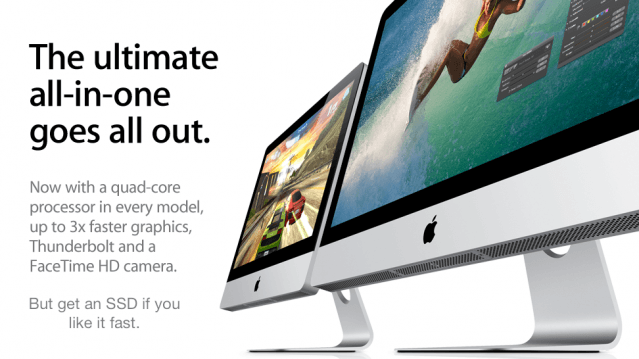Apple’s new family of iMacs launched today, featuring Intel’s latest Core i5 and i7 processors, 4GB of RAM, and 3x faster graphics; all the ingredients needed to bake a super speedy all-in-one. However, there’s one thing missing from Apple’s lineup of four ‘ready-made’ iMacs, and that’s a solid-state drive. Without one your shiny new iMac might not be as fast as you expected it to be.
Traditional hard disk drives are famously the bottlenecks that slow down modern-day Macs, and more and more people are now adopting solid-state drives thanks to their outstanding performance.
Recent tests performed by MacWorld proved that MacBook Pros equipped with SSDs were up to 20% faster than notebooks fitted with a traditional HDD. The difference means significantly faster startup times and faster disk functions that make everyday computing super quick.
For instance, MacWorld found a 15-inch MacBook Pro with a 2.0GHz processor took 39 seconds to boot up. Whereas a 13-inch MacBook Air with a 1.83GHz processor took just 15 seconds. With the SSD upgrade, a 13-inch 2.3GHz Core i5 MacBook Pro outperforms a 13-inch 2.7GHz Core i7 MacBook Pro.
These aren’t the only tests that demonstrate the differences either: simply type ‘HDD vs. SSD’ into Google and you’ll be greeted with an endless list of sites that compare the two drives – all of which find an SSD to be noticeably quicker than a HDD.
So, it’s pretty clear, then, that SSDs are the way forward. While your new iMac might boast a quad-core i5 or i7 processor, it still won’t boot up as quickly my dual-core 1.4GHz 11-inch MacBook Air, unless you fit it with an SSD. And here’s why you should buy that SSD with your iMac from Apple:
While it may be cheaper to buy RAM from a third-party and upgrade your Mac yourself after purchase, that’s not the case when it comes to upgrading your hard drive.
Firstly, Apple sees RAM as a ‘user upgradable part’, and therefore makes it easy for you to change this yourself. As for hard drives, upgrading is a great deal of work, and unless you’re highly skilled and know exactly what you’re doing, you’ll have to pay a professional to do it for you. It requires that the whole rear casing of the iMac is removed, and as such voids your machine’s warranty.
Secondly, it’s not a great deal cheaper to upgrade yourself anyway. Swapping the 1TB HDD in the low-end 27-inch iMac to a 256GB SSD increases the price by $500. It may sound pricey, but you’ll struggle to find a decent 256GB SSD from a third-party for under $400 right now. Sure, that’s $100 less, but your warranty’s worth a lot more.
After using a new 11-inch MacBook Air for the past few months, modern Macs with HDDs, despite their incredibly fast processors and countless gigabytes of RAM, still don’t feel as quick when it comes to every day computing. Go into your local Apple Store and compare the performance of a MacBook Air with your HDD-equipped computer and I bet you’ll notice the difference.
Use one for a few months and try going back to a machine without one.


